One-pot Creamy Beef and Garlic Butter Pasta
This One-Pot Creamy Beef and Garlic Butter Pasta is the kind of comforting, indulgent dinner that feels like a warm hug in a bowl. It brings together rich ground beef, buttery garlic, and a velvety Parmesan cream sauce in a single pot—no need for extra dishes or complicated steps.
The magic lies in how the pasta cooks directly in the sauce, absorbing all the savory depth from the broth, garlic, and beef.
Perfect for busy weeknights or lazy weekends, this dish delivers restaurant-quality flavor with minimal effort and maximum satisfaction.
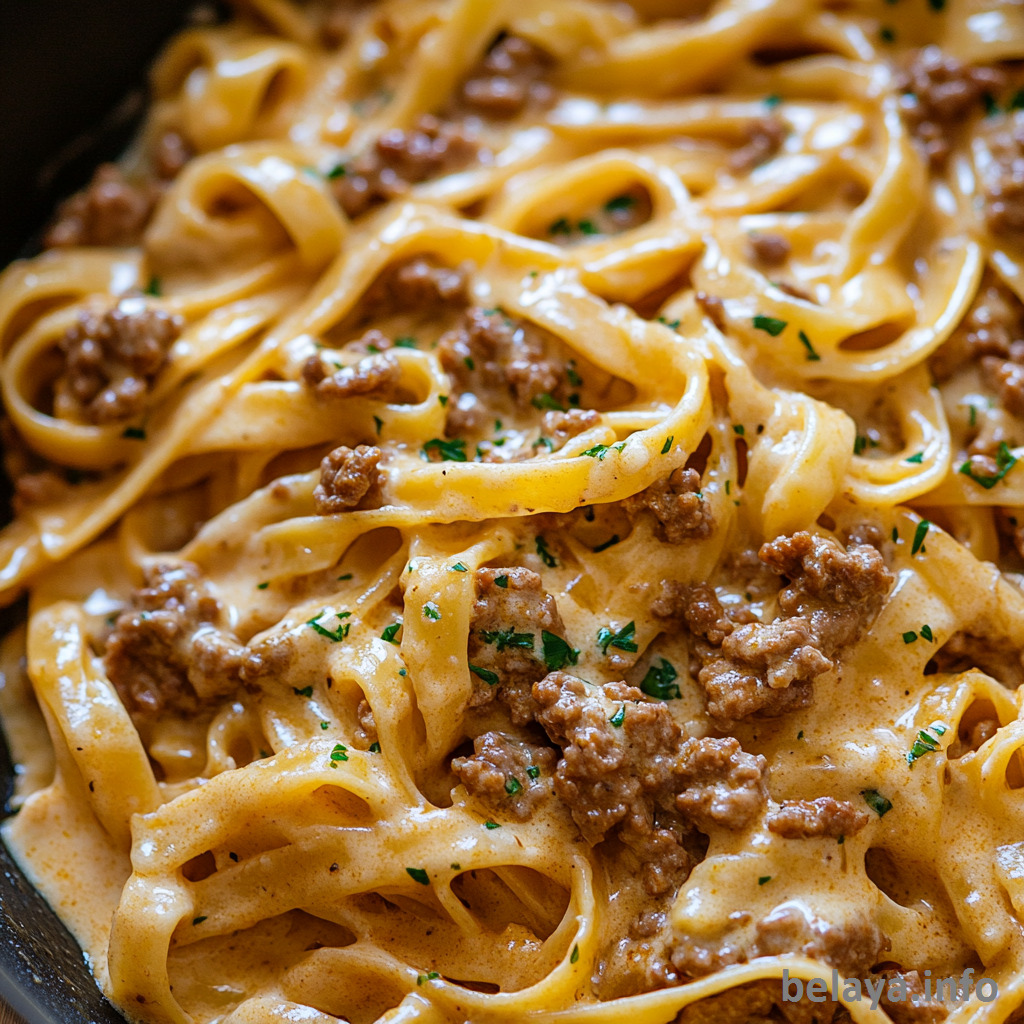
Why People Will Love This One-Pot Creamy Beef and Garlic Butter Pasta:
One-pot convenience: Everything cooks in a single pot—meat, sauce, and pasta—making cleanup quick and easy with minimal dishes to wash.
Deep, layered flavor: The combination of browned beef, sautéed garlic and onions, and a splash of broth builds a rich, savory base that tastes like it simmered for hours.
Luxurious texture: The heavy cream and Parmesan create a silky, indulgent sauce that clings perfectly to each bite of pasta.
Satisfying and filling: With protein, carbs, and fat in balance, this meal is hearty enough to satisfy even the biggest appetites.
Family-friendly favorite: It’s mild, creamy, and comforting—appealing to both picky eaters and grown-up palates alike.
Versatile and adaptable: You can swap the pasta shape, use ground turkey or chicken, or add veggies like spinach or mushrooms for variety.
Restaurant-style quality at home: It delivers a gourmet feel without complicated techniques or expensive ingredients.
Perfect for busy nights: Fast prep, no-fuss cooking, and ready in under 30 minutes—ideal for weeknight dinners or when you’re short on time.
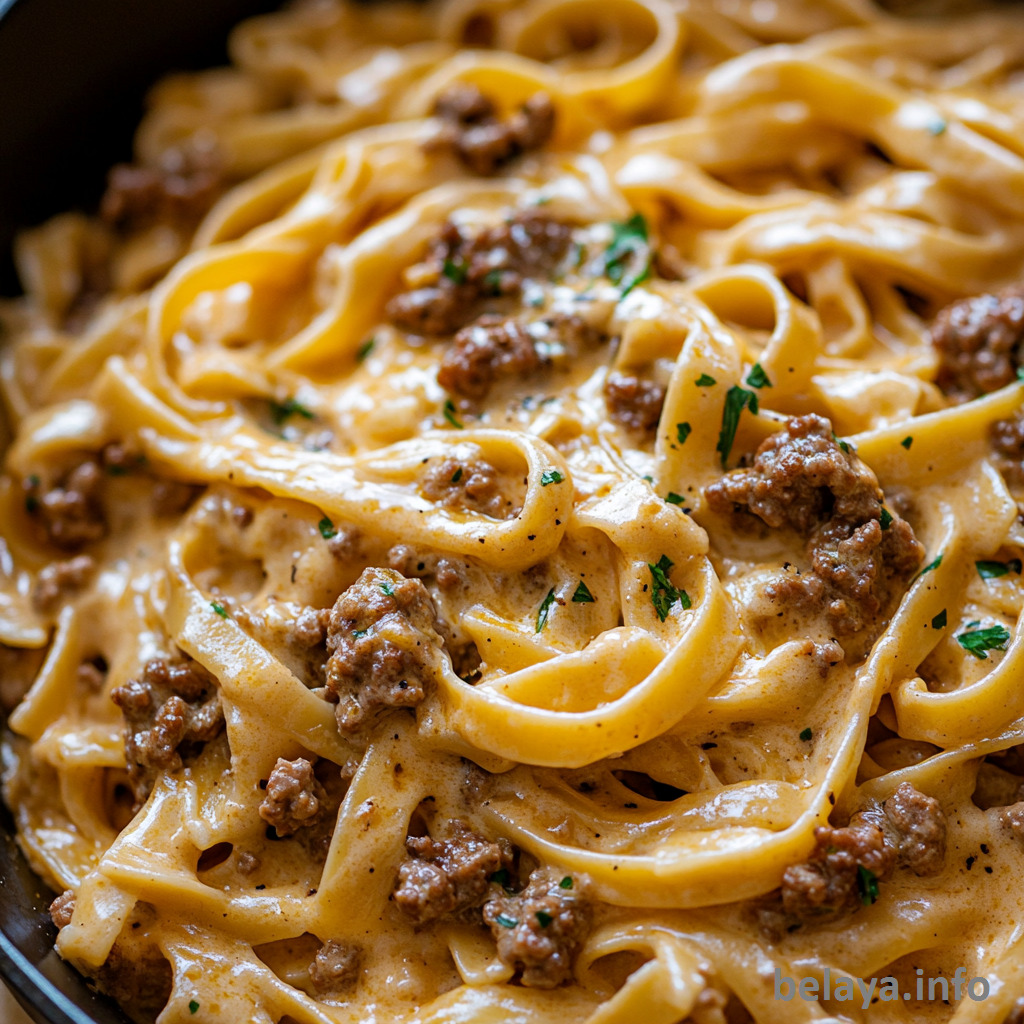
Key Ingredients:
Ground Beef: The heart of the dish, ground beef adds a rich, meaty foundation. When browned properly, it develops deep umami notes that anchor the entire flavor profile.
Garlic and Butter: This classic combination forms the aromatic base, infusing the dish with warmth and a luxurious, nutty depth that complements the cream.
Onion: Finely chopped onion adds sweetness and complexity as it softens, enhancing the savory layers of the sauce without overpowering.
Italian Seasoning: A blend of herbs like oregano, basil, and thyme gives the dish its signature Italian flair and adds subtle earthiness.
Beef Broth: Used to deglaze the pot and deepen flavor, beef broth infuses the pasta as it cooks, making each bite more flavorful.
Heavy Cream: This is what makes the sauce rich, creamy, and indulgent. It balances the savoriness of the meat and the sharpness of the cheese.
Parmesan Cheese: Adds a salty, nutty depth and helps thicken the sauce naturally. Use freshly grated for best texture and flavor.
Pasta: The starch from the pasta helps bind the sauce together. Cooking it directly in the pot allows it to soak up all the surrounding flavors.
Parsley (garnish): Fresh parsley adds a pop of color and a light, herbaceous contrast to the creamy, savory dish.
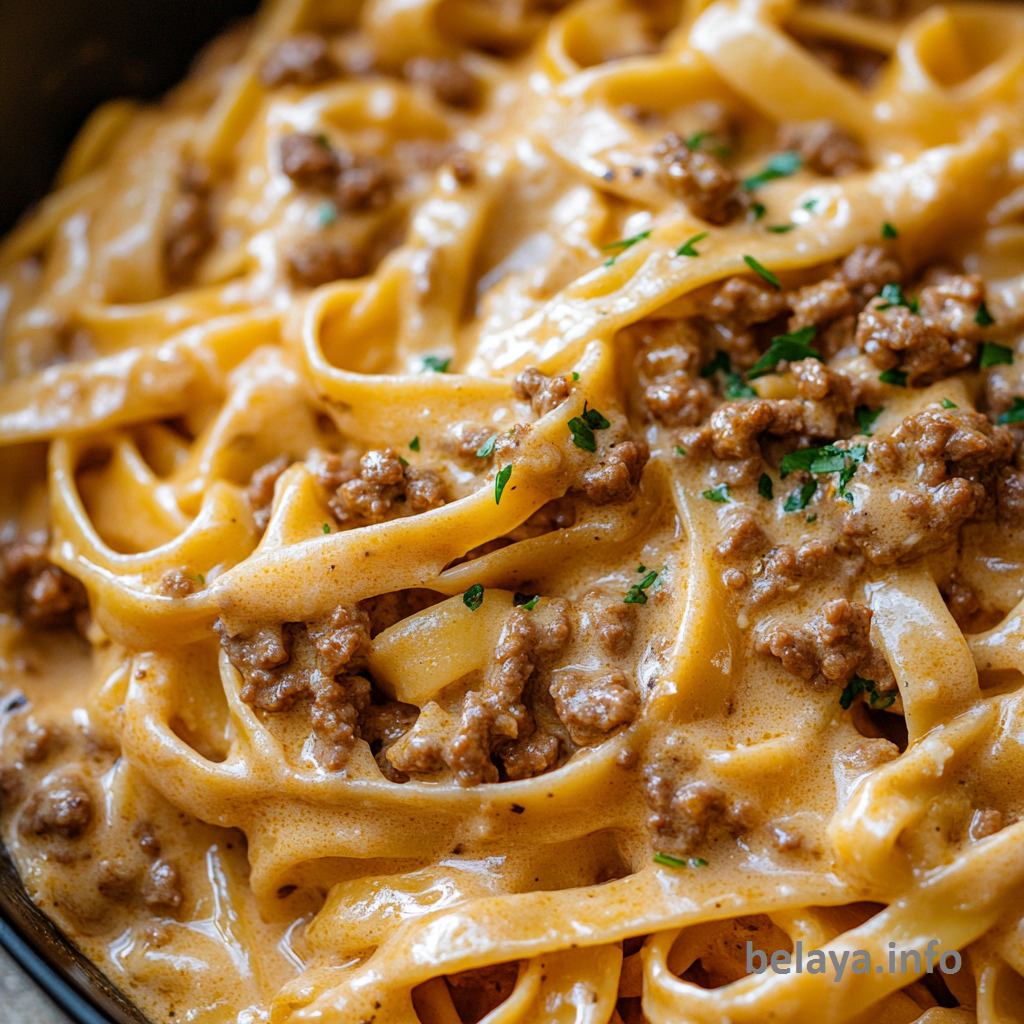
Expert Tips:
Brown the beef properly: Don’t rush this step. Let the beef sit undisturbed for a minute or two before stirring—it creates a flavorful fond (brown bits) on the bottom of the pan, which adds complexity when deglazed with broth.
Use fresh garlic and grate it finely: Fresh minced or grated garlic releases essential oils that deepen the flavor. Avoid pre-minced garlic in jars—it’s milder and less aromatic.
Sauté onions until translucent, not browned: Cook just until soft and glossy. Overcooking can add bitterness and overpower the sauce’s creamy balance.
Warm the broth before adding: Adding cold broth can slow down the cooking process and dull the flavor infusion. Warm broth helps maintain temperature and keeps the sauce smooth.
Choose high-quality Parmesan and grate it yourself: Pre-grated cheese contains anti-caking agents that can prevent smooth melting. Freshly grated cheese dissolves better and enriches the sauce.
Stir the pasta occasionally as it cooks: Since it’s simmering directly in the sauce, stirring helps prevent sticking and ensures even cooking and flavor absorption.
Watch the liquid level: The pasta absorbs a lot of moisture. Add small splashes of broth or hot water if the sauce thickens too quickly or before the pasta is fully cooked.
Let it rest before serving: Removing the pot from heat and letting it sit for 2–3 minutes allows the sauce to set and thicken slightly for a creamier, more cohesive finish.
Garnish with intention: A sprinkle of fresh parsley and an extra dusting of Parmesan right before serving adds freshness, aroma, and visual appeal.
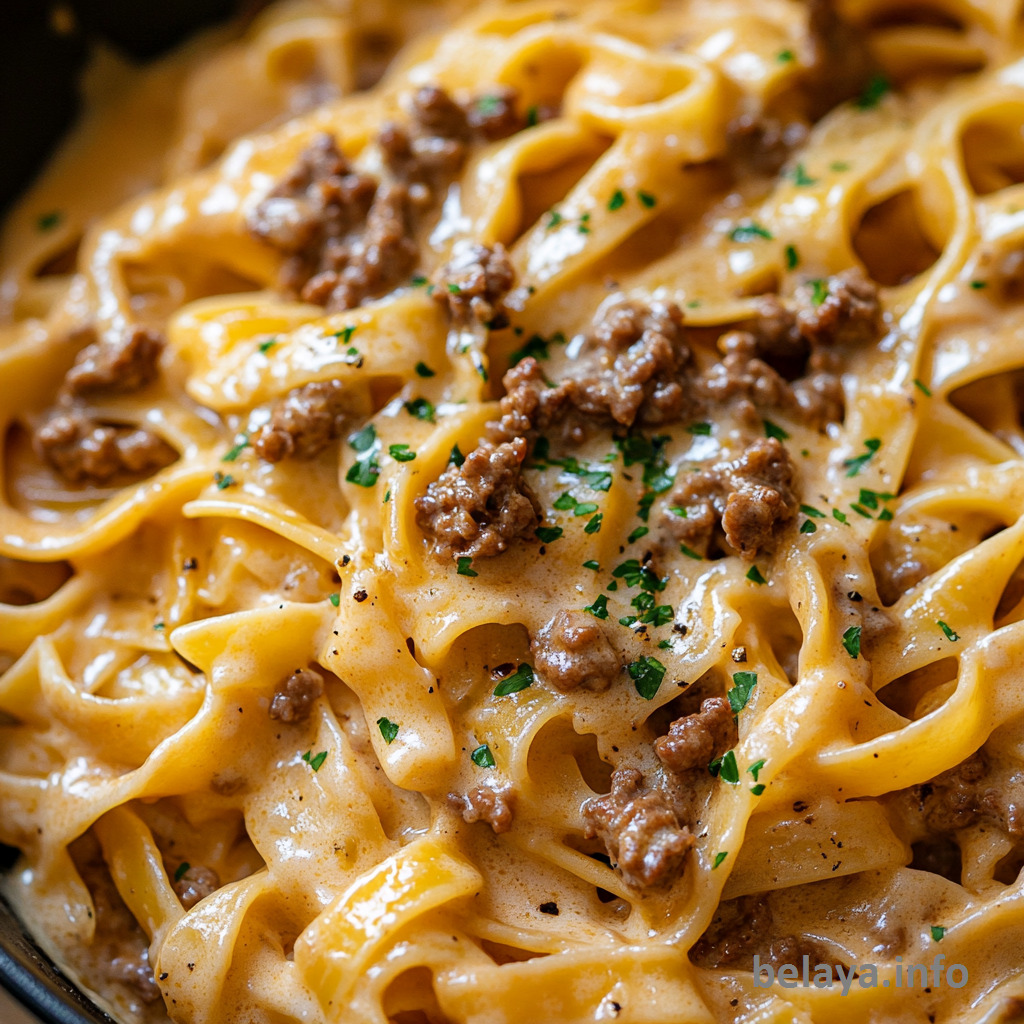
One-pot Creamy Beef and Garlic Butter Pasta
Ingredients
1 lb ground beef
2 tablespoons butter
4 cloves garlic, minced
1 medium onion, finely chopped
1 teaspoon dried Italian seasoning
1/2 teaspoon salt
1/4 teaspoon black pepper
1/2 cup beef broth
1 cup heavy cream
1/2 cup grated Parmesan cheese
8 ounces pasta (penne or spaghetti works well)
Fresh chopped parsley, for garnish
Cook Mode Prevent your screen from going dark
Instructions:
Brown the Beef:
In a large pot or deep skillet over medium heat, melt the butter.
Add the ground beef, breaking it apart with a spatula. Cook for 5–7 minutes, or until browned and cooked through.
Add Aromatics:
Stir in the minced garlic and chopped onion.
Cook for about 2 minutes, or until the onion becomes translucent and the garlic is fragrant.
Season the Base:
Sprinkle in the Italian seasoning, salt, and black pepper.
Stir well to coat the meat and aromatics evenly.
Deglaze with Broth:
Pour in the beef broth and bring to a simmer.
Let it cook uncovered for about 5 minutes, allowing the liquid to reduce slightly and intensify in flavor.
Add Cream and Cheese:
Stir in the heavy cream and Parmesan cheese.
Mix until the cheese melts and the sauce begins to thicken, about 3–4 minutes.
Cook the Pasta:
Add the uncooked pasta directly into the pot, making sure it’s mostly submerged in the sauce.
Add a splash of extra broth or water if needed.
Cover the pot and cook the pasta according to the package instructions (usually 8–10 minutes), stirring occasionally to prevent sticking.
Finish and Serve:
Once the pasta is tender and the sauce has thickened to a creamy consistency, remove the pot from heat.
Garnish with freshly chopped parsley and serve immediately.
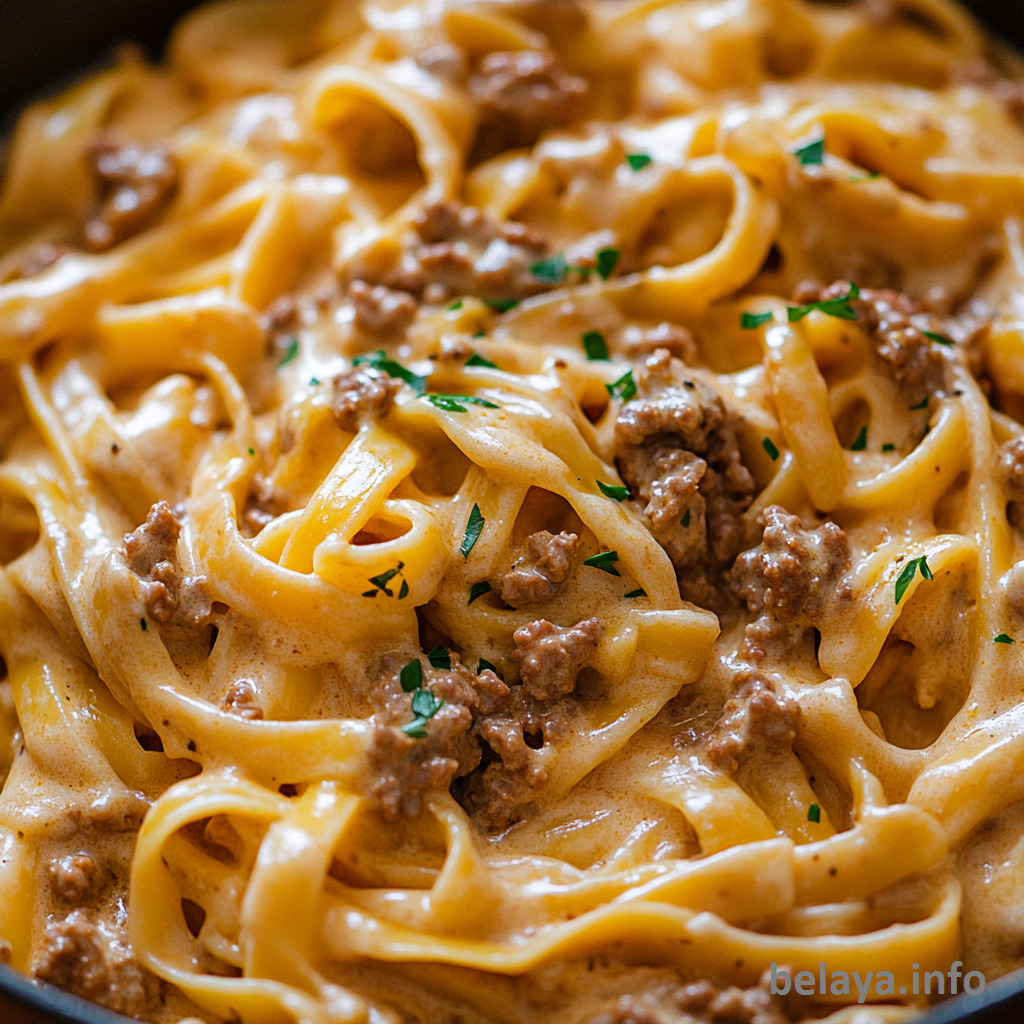
Important Notes When Making One-Pot Creamy Beef and Garlic Butter Pasta
Pasta type matters: Use short pasta like penne, rigatoni, or fusilli for even cooking and better sauce clinging. Long pasta like spaghetti works too but may require more stirring to prevent sticking.
Cook time may vary: Since pasta is cooked directly in the sauce, timing can depend on the brand and type. Always taste for doneness rather than relying strictly on package time.
Sauce thickens as it sits: The starch from the pasta continues to thicken the sauce after cooking. If the mixture looks a little loose at the end, give it a couple minutes to rest—it will become creamier.
Balance the seasoning: Taste the sauce before finishing and adjust salt carefully. Parmesan adds salinity, so it’s best to season lightly at first and adjust toward the end.
Fat content affects texture: Use full-fat cream for a rich, velvety sauce. Lower-fat alternatives may curdle or separate, especially when combined with acidic or salty elements.
Don’t skip deglazing: Scraping up the browned bits after adding broth infuses the sauce with deep, savory flavor. It’s a crucial step in building complexity in a one-pot dish.
Use a wide, heavy-bottomed pot: This helps distribute heat evenly, prevents burning, and gives enough surface area to sauté and simmer efficiently.
Leftovers reheat well—but may need moisture: When reheating, add a splash of cream, broth, or milk to revive the sauce and restore its creamy texture.
Fresh herbs elevate the finish: Even a simple sprinkle of chopped parsley at the end brightens the dish and cuts through the richness, making it feel more balanced and complete.

How to Enjoy One-Pot Creamy Beef and Garlic Butter Pasta After Cooking:
Step 1: Let It Rest Briefly
Once the pasta is tender and the sauce has thickened, remove the pot from the heat.
Let the dish sit uncovered for 2–3 minutes. This allows the sauce to finish setting, the pasta to absorb a bit more flavor, and the temperature to cool slightly for optimal serving.
Step 2: Serve with Intention
Use shallow bowls to capture the creamy sauce and make every bite satisfying.
Garnish generously with freshly chopped parsley or extra grated Parmesan for freshness and visual appeal.
Optionally, drizzle a touch of olive oil or a squeeze of lemon juice for a flavor boost.
Step 3: Pair It Well
Bread: Serve with crusty garlic bread, focaccia, or a warm baguette to mop up the extra sauce.
Salad: A light green salad with lemon vinaigrette or balsamic dressing cuts through the richness of the pasta.
Wine: Enjoy with a glass of medium-bodied red wine (like Merlot or Chianti) or a creamy white wine (like Chardonnay).
Step 4: Savor Slowly
The flavors in this dish are rich and layered—take your time to appreciate the balance of the buttery garlic, creamy sauce, and savory beef.
For a balanced bite, twirl the pasta with some meat and sauce in every forkful.
Step 5: Store & Reheat Like a Pro
To store: Transfer leftovers to an airtight container and refrigerate for up to 3 days.
To reheat: Warm gently on the stove or in the microwave with a splash of broth or milk to restore creaminess.
Stir well during reheating to ensure even texture.
Enjoying this dish is more than eating—it’s about appreciating comfort food that’s been thoughtfully prepared, one spoonful at a time.

Nutrition Information for One-Pot Creamy Beef and Garlic Butter Pasta
Based on one serving (assuming the recipe makes 4 servings):
Calories: 710 kcal | Total Fat: 45.6 g | Saturated Fat: 22.4 g | Monounsaturated Fat: 14.2 g | Polyunsaturated Fat: 2.9 g | Cholesterol: 145 mg | Sodium: 480–620 mg (depending on added salt and Parmesan) | Total Carbohydrates: 42.3 g | Dietary Fiber: 2.1 g | Sugars: 3.6 g | Protein: 31.4 g
Note: These values are approximate and can vary depending on the brand of ingredients used (especially cream, cheese, pasta, and beef). For more accuracy, use a nutrition calculator with your specific products.

Frequently Asked Questions
Can I use a different type of pasta for this recipe?
Yes! While penne and spaghetti work well, you can use any short pasta like rigatoni, fusilli, or farfalle. Just keep an eye on liquid levels and adjust cooking time according to the pasta type.
How can I make this recipe lighter without losing flavor?
You can substitute the heavy cream with half-and-half or evaporated milk, and use lean ground beef or ground turkey. Adding more herbs or a touch of lemon zest can help maintain richness without the extra fat.
Will the sauce still turn out creamy if I use pre-shredded Parmesan?
Pre-shredded Parmesan often contains anti-caking agents that prevent smooth melting. For best results and a silkier sauce, grate fresh Parmesan directly from a block.
Can I make this ahead of time?
Yes, it stores well for up to 3 days in the fridge. When reheating, add a splash of milk or broth to loosen the sauce and restore its creamy texture.
Is it possible to add vegetables to this dish?
Absolutely. Sautéed mushrooms, baby spinach, chopped zucchini, or even frozen peas can be added during or after the pasta cooks to add nutrition and texture without compromising flavor.
Do I need to cook the pasta separately before adding it to the pot?
No, the pasta cooks directly in the same pot with the sauce and beef. This not only saves time and dishes but allows the pasta to absorb the flavor of the broth and aromatics for a richer taste.
How do I prevent the pasta from sticking or clumping while it cooks?
Stir the pot every 1–2 minutes during the first few minutes of pasta cooking. This helps separate the noodles and keeps them from sticking to the bottom or each other.
When should I add the cream and cheese to avoid curdling?
Add them after the broth has simmered and reduced slightly. Lower the heat to medium-low before stirring in the cream and cheese to prevent overheating and breaking the sauce.
How can I tell if I need to add more liquid during cooking?
If the sauce is getting too thick or the pasta isn’t fully submerged, add a splash of warm broth or water. The key is to maintain enough moisture so the pasta can cook evenly while still forming a creamy sauce.
What’s the best way to balance the seasoning during cooking?
Taste at multiple points—after browning the beef, after adding broth, and again near the end. Since Parmesan and broth can be salty, it’s best to start with less salt and adjust gradually. Add black pepper or red pepper flakes at the end for a flavor boost.